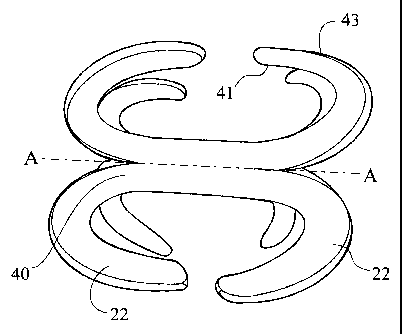Some of the information on this Web page has been provided by external sources. The Government of Canada is not responsible for the accuracy, reliability or currency of the information supplied by external sources. Users wishing to rely upon this information should consult directly with the source of the information. Content provided by external sources is not subject to official languages, privacy and accessibility requirements.
Any discrepancies in the text and image of the Claims and Abstract are due to differing posting times. Text of the Claims and Abstract are posted:
| (12) Patent: | (11) CA 2265267 |
|---|---|
| (54) English Title: | SHAPED HOT DOG AND A METHOD FOR MAKING SAME |
| (54) French Title: | SAUCISSE FUMEE FACONNEE ET METHODE DE FABRICATION |
| Status: | Term Expired - Post Grant Beyond Limit |
| (51) International Patent Classification (IPC): |
|
|---|---|
| (72) Inventors : |
|
| (73) Owners : |
|
| (71) Applicants : |
|
| (74) Agent: | SMART & BIGGAR LP |
| (74) Associate agent: | |
| (45) Issued: | 2007-07-31 |
| (22) Filed Date: | 1999-03-11 |
| (41) Open to Public Inspection: | 2000-06-07 |
| Examination requested: | 2004-03-11 |
| Availability of licence: | N/A |
| Dedicated to the Public: | N/A |
| (25) Language of filing: | English |
| Patent Cooperation Treaty (PCT): | No |
|---|
| (30) Application Priority Data: | ||||||
|---|---|---|---|---|---|---|
|
A shaped hot dog, and a method of forming a shaped hot dog from an elongated generally cylindrical wiener. The wiener is provided with cuts extending longitudinally from each end a distance selected to maintain a cylindrical middle portion intact. The cuts form distal portions which extend away from each side of the middle portion. The distal portions curl outwardly on cooking, and the resulting shaped hot dog has an appealing shape which in a preferred embodiment resembles a spider.
Un hot dog façonné, et un procédé de fabrication d'un hot dog façonné à partir d'une saucisse de Francfort de forme allongée généralement cylindrique. La saucisse de Francfort est pourvue d'entailles s'étendant longitudinalement à partir de chaque extrémité, à une distance sélectionnée afin de maintenir intacte la partie médiane du cylindre. Les entailles forment des portions distales qui s'étendent en s'éloignant de chaque côté de la partie médiane. Les portions distales se recroquevillent vers l'extérieur pendant la cuisson, et le hot dog façonné qui en résulte présente une forme attirante qui, dans une réalisation préférentielle, ressemble à une araignée.
Note: Claims are shown in the official language in which they were submitted.
Note: Descriptions are shown in the official language in which they were submitted.

2024-08-01:As part of the Next Generation Patents (NGP) transition, the Canadian Patents Database (CPD) now contains a more detailed Event History, which replicates the Event Log of our new back-office solution.
Please note that "Inactive:" events refers to events no longer in use in our new back-office solution.
For a clearer understanding of the status of the application/patent presented on this page, the site Disclaimer , as well as the definitions for Patent , Event History , Maintenance Fee and Payment History should be consulted.
| Description | Date |
|---|---|
| Inactive: Expired (new Act pat) | 2019-03-11 |
| Inactive: IPC deactivated | 2016-03-12 |
| Inactive: IPC from PCS | 2016-01-09 |
| Inactive: IPC expired | 2016-01-01 |
| Inactive: Payment - Insufficient fee | 2008-03-27 |
| Grant by Issuance | 2007-07-31 |
| Inactive: Cover page published | 2007-07-30 |
| Pre-grant | 2007-05-14 |
| Inactive: Final fee received | 2007-05-14 |
| Notice of Allowance is Issued | 2006-11-14 |
| Letter Sent | 2006-11-14 |
| Notice of Allowance is Issued | 2006-11-14 |
| Inactive: Received pages at allowance | 2006-09-18 |
| Inactive: Office letter | 2006-08-24 |
| Inactive: Approved for allowance (AFA) | 2006-05-11 |
| Inactive: IPC from MCD | 2006-03-12 |
| Amendment Received - Voluntary Amendment | 2006-02-17 |
| Inactive: S.30(2) Rules - Examiner requisition | 2005-08-18 |
| Letter Sent | 2004-03-19 |
| Request for Examination Received | 2004-03-11 |
| Request for Examination Requirements Determined Compliant | 2004-03-11 |
| All Requirements for Examination Determined Compliant | 2004-03-11 |
| Inactive: Entity size changed | 2002-03-19 |
| Application Published (Open to Public Inspection) | 2000-06-07 |
| Inactive: Cover page published | 2000-06-06 |
| Inactive: First IPC assigned | 1999-04-30 |
| Inactive: IPC assigned | 1999-04-30 |
| Inactive: IPC assigned | 1999-04-30 |
| Inactive: Filing certificate - No RFE (English) | 1999-04-16 |
| Application Received - Regular National | 1999-04-15 |
There is no abandonment history.
The last payment was received on 2007-03-12
Note : If the full payment has not been received on or before the date indicated, a further fee may be required which may be one of the following
Patent fees are adjusted on the 1st of January every year. The amounts above are the current amounts if received by December 31 of the current year.
Please refer to the CIPO
Patent Fees
web page to see all current fee amounts.
Note: Records showing the ownership history in alphabetical order.
| Current Owners on Record |
|---|
| GREGORY F. FLEETHAM |
| Past Owners on Record |
|---|
| None |